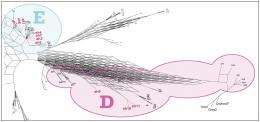July 30, 2012 report
Researchers track global dispersion of chickens throughout history using DNA

(Phys.org) -- The lowly chicken has had a remarkable impact on human history, providing a food source for innumerable people over the years. Modern scientists believe chickens (Gallus gallus) were first domesticated over 5000 years ago somewhere in Southeast Asia, and since that time have been carried to every place that humans exist. Tracking their migration helps historians track human migration. Now new research by a team made up of people from a variety of sciences from around the world has found, using mitochondrial DNA evidence from bones of ancient chickens, what they believe to be the great-grandmother’s of the modern chicken. They have published their findings in the journal PLoS One.
Because humans have had such a long history of moving chickens around, it’s been difficult to pin down just where they came from originally, that’s why the team decided to turn to mitochondrial DNA testing. They examined the bones of 48 chickens that have been found in various archeological sites all over the world, and which were in good enough condition to extract mitochondrial DNA. They focused particularly on a strand known as the D-Loop, because it’s not involved in functional genes which means they are retained generation after generation. In that sequence, they found clear similarities between all of the chicken samples, which they say proves that chickens all came from a common ancestor. And because the samples found in Southeast Asia (India, Malaysia and Burma) were the oldest, they were able to narrow down the origin of the chicken to one of those three countries or maybe one nearby.
Prior to domestication, researchers believe chickens were simple junglefowl, which don’t migrate. This means the birds could only get to the other places they’ve traveled through being carried by people, because no other means has been found. Thus, in tracking the different locations of the birds over time, it’s possible to also track the migration of people. The research team believes for example, that chickens arrived in the Americas via several routes; Polynesia, Europe and Africa and perhaps directly from Asia, which of course coincides with theories regarding how people first arrived.
Unfortunately current technology can’t yet clear the picture entirely, but the researchers are confident that advances over the next few years will allow them to pin down the actual location of the first domesticated chicken and settle the matter once and for all.
More information: Storey AA, Athens JS, Bryant D, Carson M, Emery K, et al. (2012) Investigating the Global Dispersal of Chickens in Prehistory Using Ancient Mitochondrial DNA Signatures. PLoS ONE 7(7): e39171. doi:10.1371/journal.pone.0039171
Abstract
Data from morphology, linguistics, history, and archaeology have all been used to trace the dispersal of chickens from Asian domestication centers to their current global distribution. Each provides a unique perspective which can aid in the reconstruction of prehistory. This study expands on previous investigations by adding a temporal component from ancient DNA and, in some cases, direct dating of bones of individual chickens from a variety of sites in Europe, the Pacific, and the Americas. The results from the ancient DNA analyses of forty-eight archaeologically derived chicken bones provide support for archaeological hypotheses about the prehistoric human transport of chickens. Haplogroup E mtDNA signatures have been amplified from directly dated samples originating in Europe at 1000 B.P. and in the Pacific at 3000 B.P. indicating multiple prehistoric dispersals from a single Asian centre. These two dispersal pathways converged in the Americas where chickens were introduced both by Polynesians and later by Europeans. The results of this study also highlight the inappropriate application of the small stretch of D-loop, traditionally amplified for use in phylogenetic studies, to understanding discrete episodes of chicken translocation in the past. The results of this study lead to the proposal of four hypotheses which will require further scrutiny and rigorous future testing.
Journal information: PLoS ONE
© 2012 Phys.Org
















